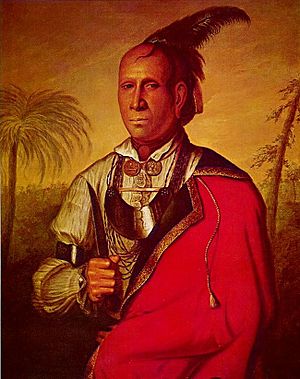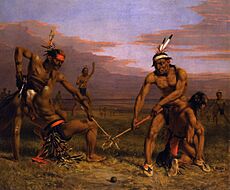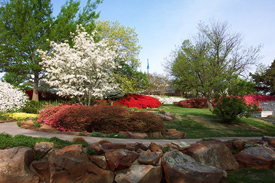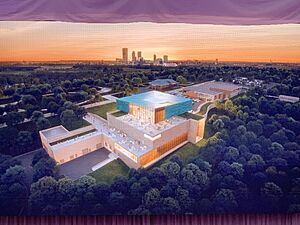Gilcrease Museum facts for kids
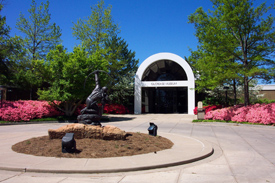
Gilcrease Museum main entrance
|
|
| Former name | Gilcrease Institute |
|---|---|
| Established | 1943 |
| Location | Tulsa, Oklahoma |
| Type | Art Museum |
| Founder | Thomas Gilcrease |
| Owner | City of Tulsa |
The Gilcrease Museum is a special place in Tulsa, Oklahoma. It is also known as the Thomas Gilcrease Institute of American History and Art. This museum holds one of the world's largest collections of art from the American West. It also has many amazing art pieces and artifacts from Central and South America.
The museum is named after Thomas Gilcrease, who was an oil businessman and loved collecting art. He started this huge collection himself. In 1958, he gave his entire collection, the museum building, and the land to the City of Tulsa. Since 2008, the Gilcrease Museum has been managed by a team from the City of Tulsa and the University of Tulsa. A special research center, the Helmerich Center for American Research, was added in 2014. It cost $14 million and provides a safe place for researchers to study over 100,000 books, documents, and maps from the museum's collection.
Contents
History of the Gilcrease Museum
Thomas Gilcrease grew up in what was then the Muscogee (Creek) Nation, in eastern Oklahoma. Around 1900, the U.S. government changed how land was owned by American Indian tribes. Thomas Gilcrease, as a tribal member, received 160 acres (0.65 km2) of land near Tulsa. This land later became part of a major oil field called the Glenn Pool Oil Reserve.
Thomas Gilcrease was a very smart businessman. In 1922, he started the Gilcrease Oil Company. In less than ten years, he had made his company much bigger. He traveled a lot in Europe during the 1920s and 1930s. Visiting museums there gave him the idea to start his own collection. He was proud of his American Indian background and interested in the history of the American West. This helped him decide what to collect.
How the Collection Grew
Gilcrease bought his first oil painting in 1912. It was called Rural Courtship by Daniel Ridgway Knight and cost $1,500. However, most of his collection was gathered after 1939. The first Gilcrease Museum opened in 1943 at his oil company's office in San Antonio, Texas. A few years later, he moved his company and his growing collection back to Tulsa. He opened a gallery for the public to see his art on his Tulsa property in 1949.
Gilcrease collected art at a time when not many people were interested in the art or history of the American West. Because of this, his collection grew very quickly. In the early 1950s, he bought many works of art, artifacts, and historical documents. But then, oil prices dropped, and it became hard for him to afford new purchases. To keep his collection together, Gilcrease offered to sell everything.
In 1954, some Tulsa citizens worried that the Gilcrease Museum might leave their city. They organized a vote for a special bond (a type of loan). The people of Tulsa voted to approve the bond, which paid off Gilcrease's debts. This kept the amazing collection in Tulsa.
Thomas Gilcrease then officially gave his collection to the City of Tulsa in 1955. In 1958, the Gilcrease Foundation gave the museum buildings and land to the city. Thomas Gilcrease also promised money from his oil properties to help the museum until the bond was paid back. Even after giving the collection away, he kept funding archaeological digs and buying more items. When he passed away in 1962, he left everything he had collected in his final years to the museum.
Famous Artists at Gilcrease
Many famous American artists have their work shown in the Gilcrease Museum's American West Gallery. You can see important pieces by Albert Bierstadt, Frederic Remington, Thomas Moran, and Joseph Henry Sharp. Works by Charles Marion Russell, Alexandre Hogue, and John James Audubon are also on display. After artist William Robinson Leigh died in 1955, his wife gave his New York studio to the Gilcrease Museum.
Thomas Gilcrease believed that the story of the American West could be told through art. He also felt that the history of Native Americans and his own heritage could be shown through painting, sculpture, and other art forms. He supported many Native American artists of his time. He bought over 500 paintings by 20th-century Native American artists alone.
The Gilcrease Museum has a long-term exhibition about Native American art called Enduring Spirit: Native American Artistic Traditions. This exhibit lets the museum show off its strong collection of Native American art in a complete way. Today, the museum owns about 10,000 pieces of art. This includes 18 of the 22 bronze sculptures created by Frederic Remington.
On July 1, 2008, the University of Tulsa began helping to manage the museum. This is a partnership with the City of Tulsa.
Anthropology Collections
At Gilcrease Museum, the anthropology collections focus on the cultural history of North, Central, and South America. Anthropology is the study of human societies and cultures. The museum has 300,000 artifacts. These include items from prehistoric times and later history. They cover archaeology (studying old things) and ethnographic materials (studying cultures). These come from Native American, Hispanic, pre-Columbian (before Columbus), and Anglo-American traditions.
These many different items help tell the story of the many people and cultures that have shaped the history of the Americas. Important archaeological items at Gilcrease Museum come from the Mississippi valley region (like Illinois and Arkansas). There are also items from the southwestern U.S. (like Colorado, New Mexico, and Arizona) and ancient Mexico.
Gilcrease Museum has one of the most important collections of pre-Columbian projectile points (like arrowheads and spearheads) in North America. Archaeologists often come to study them. The museum also has a research area called the Kravis Discovery Center. It has special shelves for artifacts and a computer system to help find pieces. This center also has many "touchable" items for visitors to experience hands-on.
Archival Collection
The archival collection at Gilcrease Museum has over 100,000 books, handwritten papers, documents, and maps. These items date from 1494 to today. Some very special items include:
- A letter written and signed by Diego Columbus in 1512.
- The Cortez Decree from 1521.
- Copies of the Declaration of Independence and the Articles of Confederation (one signed by Benjamin Franklin).
- A letter written by Thomas Jefferson dated July 1, 1776.
The museum also has many papers from Cherokee principal chief John Ross and Choctaw Chief Peter Pitchlynn.
Helmerich Center for Research
The Helmerich Center for American Research is a special building on the museum grounds. It allows researchers to look at the many rare documents the museum owns. These items can only be used in the Reading Room. This room has controlled temperature and humidity to protect the documents. It is also a very secure area to keep them safe.
The documents themselves are stored in a strong concrete building. This building was designed to protect them from severe weather like tornadoes. The safe hallway connecting the Reading Room to the storage area was inspired by the "Vasari Corridor" in Florence, Italy. The same building that holds the Reading Room also has the Great Hall. This large space is used for events like fundraisers, conferences, and short art displays. The center was designed by Hastings & Chivetta and was finished in 2014. It has 32,000 square feet (2,973 m2) of space and cost about $14 million to build.
Gilcrease Gardens
The Gilcrease Museum has beautiful themed gardens on 23 of its 460 acres (1.9 km2). These gardens are designed to match the museum's collections. They show gardening styles and techniques from four different time periods in the American West:
- Pre-Columbian (before Columbus)
- Pioneer
- Colonial
- Victorian
There is also a rock garden. Gilcrease is the only art museum known to have these educational gardens all in one place, nestled in the Osage Hills. You can arrange special tours of the gardens by making an appointment.
New Museum Building
In 2016, voters approved a sales tax to provide $65 million for a big expansion of Gilcrease Museum. However, it was later decided that fixing up the old museum would be too expensive. So, the plan changed to building an entirely new museum for $83.6 million. The old building was taken down, and construction on the new one began in 2022. The new museum is expected to be finished by early 2025. The Helmerich Center, Thomas Gilcrease's original house, and his mausoleum on the property will all remain.
See also


